When most people think of the military, they think of tanks, guns, fighter jets, and other instruments of death and destruction. What often goes unnoticed is the immense logistical effort it takes to get all that equipment, the people who operate it, and the stuff they need to do it all the way around the world. But that effort shined last month when it geared up to evacuate more than 124,000 people out of Afghanistan as the United States ended its 20-year war there.
In particular, the airmen of the little-known 521st Air Mobility Operations Wing headquartered at Ramstein Air Base, Germany made their presence felt throughout Operation Allies Refuge, the mission to get Afghans who helped the U.S. out of the country so they would not be retaliated against by the victorious Taliban. If not for the 521st, tens of thousands of Afghans would likely still be trapped there.
But the evacuation was far from easy, and several senior officers and the command chief of the 521st told Task & Purpose how hard their airmen worked to pull it off.
“Think of Hartsville, or Atlanta, or any other airport in a very short period of your non-COVID Thanksgiving travel,” said Col. Adrienne Williams, commander of the 521st. “Now beef it up 200 to 400% and that’s what we were processing. And sustain it for two weeks.”
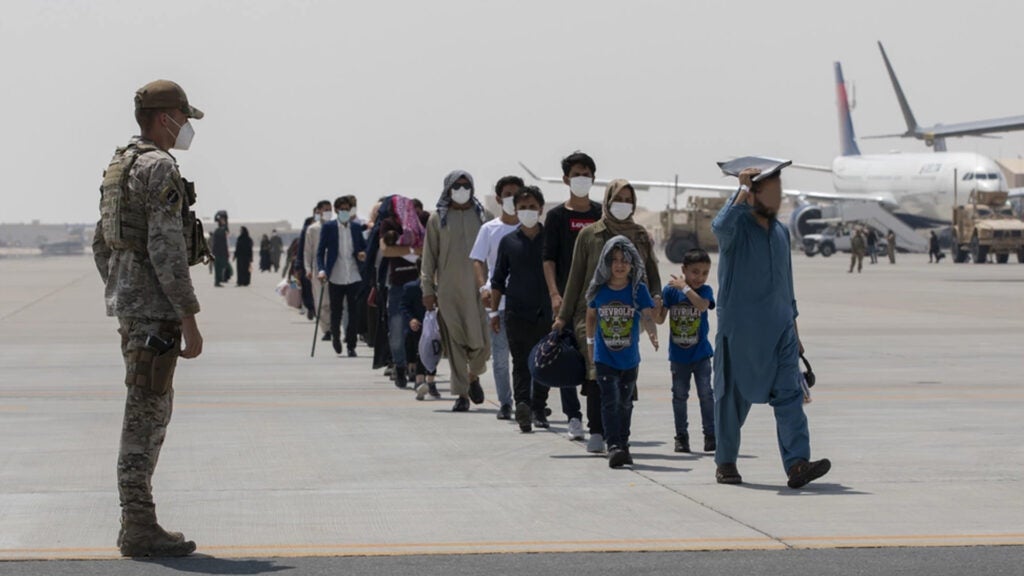
‘It was a sight to be seen’
Many people reading this may not have heard about the 521 AMOW before today, but the unit plays an outsized role in the U.S. military machine. The command is spread over 19 bases in 15 countries and 5,000 miles between the Middle East, Africa, and Europe. Like its sister unit in the Pacific, the 515th AMOW, the 521st enables way more air traffic to flow through tiny airbases in order to support operations closer to the fighting. That ability comes in handy when, say, more than half the military’s fleet of C-17 Globemaster III cargo jets are heading to Kabul, Afghanistan to evacuate more than 120,000 people, which is what happened from July 30 to Aug. 31 this year as part of Operation Allies Refuge.
The Air Force’s Air Mobility Operations Wings are like the Swiss army knives of military airports: their ranks include “port dawgs,” who move cargo and passengers into and out of aircraft as quickly as possible; maintainers who patch up the aircraft when they need a fix; command and control experts who manage the air traffic situation overhead and the flight line on the ground; aeromedical evacuation airmen who safely transport wounded passengers off the aircraft; and flight crew support specialists who take care of the people who fly the planes.
“We really put the ‘rapid’ in rapid global mobility,” Williams explained. “We’re there basically to catch the planes, catch the crews and just keep the mission moving.”
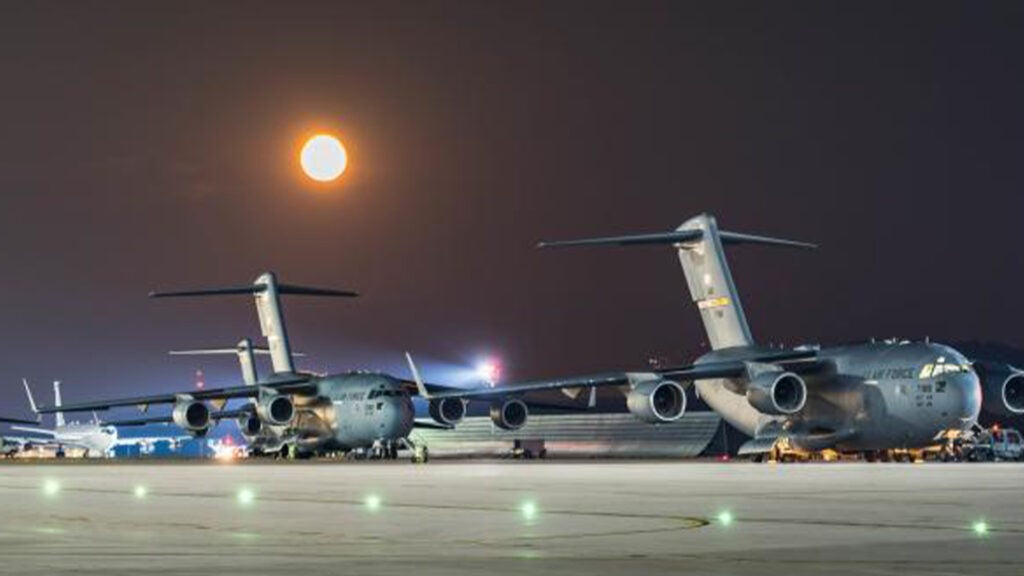
Even so, Operation Allies Refuge pushed the airmen of the 521st to the limits of their skills and endurance. They quickly had to figure out how to process more than 120,000 people of a wide range of ages, medical conditions and final destinations. After taking off from Kabul, nearly all of the Afghan refugees spent some time at Al Udeid Air Base, Qatar, where the 8th Expeditionary Air Mobility Squadron worked the flight line in the desert heat.
“Our maintainers, an absolutely amazing group of people, were on the flight line for 12+ hours a day maintaining aircraft and generating airlift in 120-degree temperatures,” said Lt. Col. Tom Reynolds, the commander of the 8th EAMS, also known as “The Mighty Ocho.”
Reynolds said that, despite the conditions, airmen stayed on the flight line as long as they could, “that’s how much they care and how much they were invested,” he said.
While the maintainers worked the aircraft, the port dawgs, flight crew support, and aeromedical evacuators were busy helping process and care for the refugees. It doesn’t say “assist in the largest non-combatant evacuation airlift in American history” in any of those job descriptions, but that’s what they did, and Reynolds said he was amazed by the heart and compassion with which his airmen took to the task.
“Our airmen were helping bring strollers off the buses, getting them bedded down, making sure they had water, food, walking them to the aircraft, and making sure they were okay,” he said. “It was a sight to be seen. This was, you know, six days into this thing. They were tired and beat down and overwhelmed and working 12+ hour days. And to see them continue to take that compassion is amazing.”
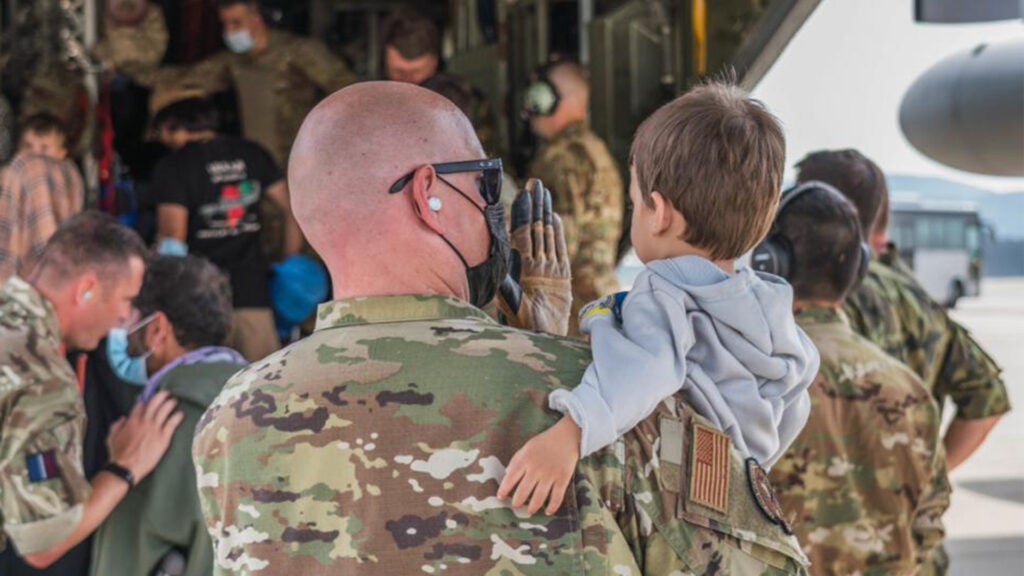
As Operation Allies Refuge went on, the airmen of the Mighty Ocho got even better at their new job of taking care of refugees, especially when it came to giving out food. What started as simply handing out Meals Ready to Eat and water soon transformed into airmen driving refrigerated trucks delivering cold water and fresh food to Afghan travelers. They even developed the call sign “waterboy” for the teams driving the trucks, Reynolds explained.
Still, the system was far from perfect. Colin Sullivan, a State Department official, said in a leaked email that “Where the Afghans are housed is a living hell. Trash, urine, fecal matter, spilled liquids and vomit cover the floors,” according to Axios.
“I spent an hour in there picking up trash … almost suffocated,” Sullivan said, quoting Doha Embassy staff communications about the base. “Another flight arrived and there’s no resources to solve the sanitation problem … These human beings are in a living nightmare.”
One service member involved in the airlift also told Task & Purpose that refugees were sometimes stuck on the flight line at Al Udeid in sweltering conditions for hours at a time while they awaited processing.
“It’s a miracle no one has died yet,” the service member said.
1st Lt. Emma Quirk, a spokesperson for the 521st AMOW, said the unit prioritized “safety and security” for the evacuees, particularly in the early days of the operation.
“This resulted in situations that were less-than-comfortable but not unsafe, and certainly better than the imminent danger evacuees faced in Afghanistan,” she said.
At the evacuation’s height, there were more than 46 C-17s on the ramp at Al Udeid, supporting up to 35 daily launches, Quirk said. Amid the chaos, airmen were still boarding the flights to provide water and medical care for evacuees. They also hired a local catering company to provide “three daily Afghan cuisine meals” to evacuees and had mental health professionals standing by, Quirk said.
“All of this was accomplished at the peak of summer, with daily temperatures regularly reaching in excess of 110 degrees Fahrenheit at an installation that was not designed to accommodate this type of operation,” she added.
Al Udeid had a reputation for being “an armpit” and “like standing on the sun” even before it was flooded with one of the largest evacuations in recent history. For example, Military Times wrote an article about five dishes at “The Deid” that came with termites, worms, mold or rocks. The airmen at Al Udeid no doubt did their best to care for refugees under those conditions.
“While the operation continued, we were trying to find quicker, faster, and more efficient ways to move passengers to where they were taken care of so they didn’t have to be on an aircraft,” Reynolds said. “It was our airmen on the buses taking care of the passengers, helping them lift strollers on airplanes, getting them bedded down, making sure they had water, food. Just amazing work by our team.”

Airport Ramstein
Thankfully, Al Udeid was not the end of the line for most of the Afghans leaving Kabul. Many of them then went north a few thousand miles to Ramstein Air Base, Germany, where they awaited flights to the U.S. or elsewhere. But, like at Al Udeid, the airmen there quickly had to figure out how to manage thousands of travelers in a very short amount of time.
“They sent walls of people: I think 9,000 in one day was the highest number, and 34,600 total is how many we received at Ramstein,” said Lt. Col. Matt Bryan, 721st Mobility Support Squadron Director of Operations and 721 Air Mobility Operations Group Interagency Coordinator.
“After we went through the bulk of taking all these passengers, the next step was ‘ok we need to figure out how we’re going to transfer these passengers onto another aircraft and get them into the United States,’” Bryan explained.
The existing passenger terminal at Ramstein wasn’t nearly big enough to accommodate thousands of passengers a day, so the 521st AMOW needed to set up a new terminal as soon as possible. Luckily, the base had an unoccupied hangar built to house a C-5 Galaxy, a cargo jet which is almost the length of a football field and is the largest aircraft in the U.S. military. Hangar 5, as the installation is called, is also the largest overseas hangar in the Department of Defense, Bryan explained, so it would be the perfect place to convert into an impromptu nine-gate international airport terminal.
However, setting up an international airport terminal takes a lot of work and coordination with multiple government agencies, including the Transportation Safety Administration, Customs and Border Patrol, and the State Department. Bryan said he and his interagency counterparts got together, wrote up a layout, and went to work. CBP set up an initial screening checkpoint to collect traveler information and make sure the passengers were cleared to enter the United States; TSA set up a security checkpoint to scan passengers just like they would in any civilian airport; and the airmen at the base itself laid out hundreds of cots for passengers to sleep on if they had a late-night flight.
The United Services Organization even set up an all-volunteer medical station and a supply center with donated materials like diapers, baby clothes, food, and even winter coats for the cooler German weather.
“You’d walk through one day and see a big pile of donations and you’re like ‘wow that’s fantastic.’ And then you walk in the next day and the airmen have turned it into a baby store, with everything hanging nicely,” said Lt. Quirk, the spokesperson for the 521st AMOW. “They just turned it into this comfortable travel experience.”
Beyond being stocked with amenities, Hangar 5 also became just as organized as any other airport terminal, Bryan said. Command and control airmen used whiteboards to keep track of air traffic, flight status, the number of passengers getting on each flight, where each plane was parked, and how many people were moving through the terminal each day.
“That was again something they just created out of necessity, like ‘hey we need to control this and we’re going to do it,’” Bryan said. “They went to the old-fashioned markerboard and it worked flawlessly.”
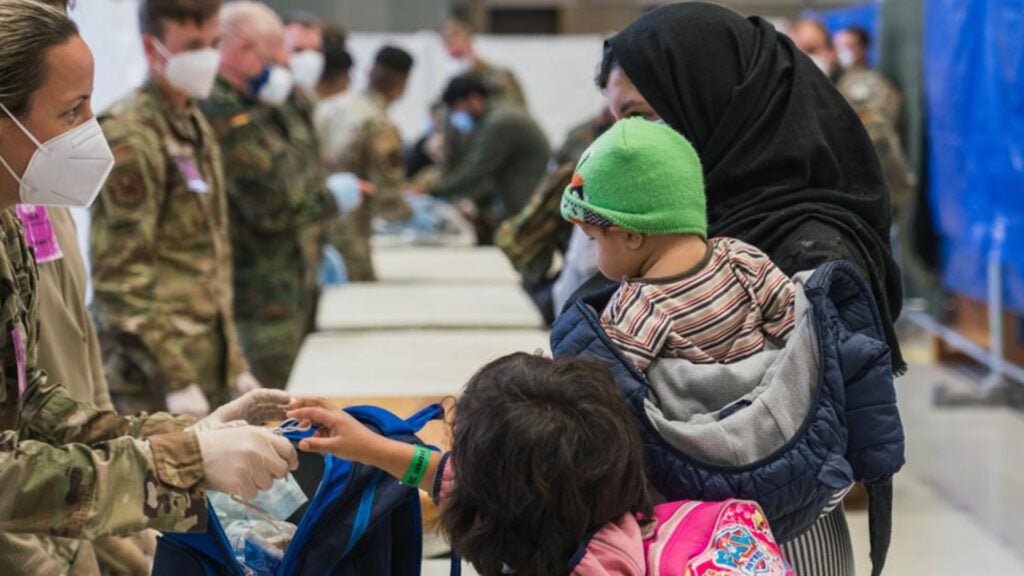
‘The machine just kind of shifted’
Though Operation Allies Refuge was a mission of mercy, the experience gained from it will serve the 521st AMOW well in a time of war, when the military may need to send a huge number of troops and supplies through tiny air bases on their way to a large-scale operation. 521st AMOW officials said the flexibility and competence their airmen displayed during the evacuation is exactly what the military will need at that moment.
“Let’s say the balloon goes off: we’ve got to send that power forward, and they’re going to come on strategic airlift or on [civil reserve air fleet] and it’s going to be whatever force is needed,” said Col. Williams, the commander of the 521st AMOW. “They’re going to come through all our nodes. And so, depending on where they’re coming in, what route of flight, we’re going to shift to catch them to keep them flowing.”
The 521st did plenty of shifting during the evacuation, too. Unit officials pointed out that, even while record numbers of refugees were flowing through their bases, the unit’s typical mission of moving troops and supplies to the military’s worldwide bases never stopped. Bryan said that, instead of stopping those flights coming through refugee-saturated Ramstein, they just routed them through nearby Spangdahlem Air Base.
“The machine just kind of shifted, it kind of evolved,” he said. “We had a flow of passengers this way and instead of sending the cargo through the same channels, it just goes around and finds other nodes to move on. So the whole system kept flowing and nothing got bogged down.”
Another example of that flexibility involved aeromedical evacuation airmen who took on the role of Passenger Medical Augmentation Personnel. The PMAPs flew aboard evacuation flights going into and out of Kabul. Bryan said that role came about in response to Afghan passengers needing medical attention while in the air.
“They weren’t doctors, but they were technicians trained to recognize certain conditions and communicate those to the aircraft commander who then communicated to the ground,” Bryan said. “So if there was something coming in we knew exactly what the problem was and what needed to be taken care of.”
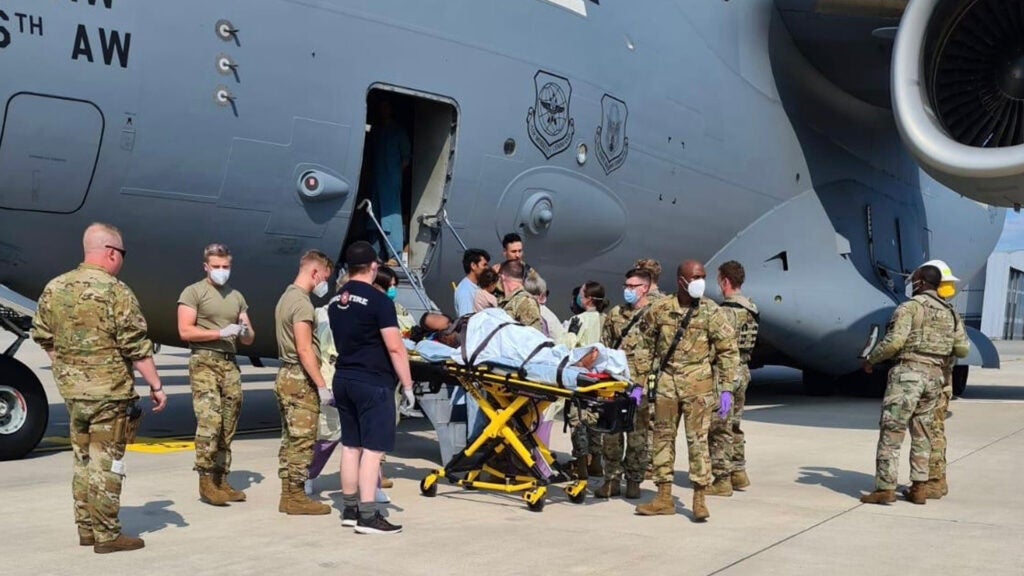
The PMAPs paid off big time in late August when several babies were born on evacuation flights or shortly after those flights landed. The most famous of them was an Afghan girl who was named Reach after the call sign of the jet that brought her and her mother from Qatar to Ramstein.
“It was one of those airmen on one of those [PMAP] teams that delivered the baby on flight,” said Col. Williams, who, with a daughter of her own, was deeply moved by the episode.
“We were out there on the ramp when that happened,” she said. In the end, it meant a lot “just knowing that that young baby is going to have a chance to be anything she wants to be, just because of all the airmen and their hearts and their belief in this operation.”
More great stories on Task & Purpose
Want to write for Task & Purpose? Learn more here and be sure to check out more great stories on our homepage.
